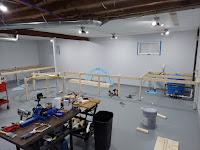And so it begins . . . wood cut to length and screwed together. I know some of my local RR buddies were beginning to think I was all talk and no action since I've been talking about this for two years. But it has finally happened and I for one am thrilled to death. To date, I have constructed the base for helix one and two. Had to shift some plumbing leaving the well tank to get the clearance to allow the helix track to go between the pipe and the wall.

After getting the bases for helix 1 and 2 in place and level (at the same height), I started laying out the east peninsula for helix 2. I learned during the construction of the bases that the floor level varies as much as 3/4" from place to place. This prevented me from determining the height of one leg and then measuring and cutting 15 legs to one length. Thank God for laser levels! This will definitely be a cut-as-you-go project. Mass cutting of legs ain't gonna work! To determine the length of each leg, I placed my 4' rule in the spot where the leg will be and then read the measurement at the red laser line on the rule. Then I subtracted 3/4" from that measurement to allow for the adjustable foot at the bottom of the leg.
The framework was assembled using butt joints with pocket screws. My objective is to keep most all screws accessible after completion. This will allow for a support member to be relocated in the event it interferes with anything that protrudes below the base of the layout, for example, tortoise switch machines. Plus, the pocket screw joints are much stronger than simple butt joints.
Once the helix bases were framed up, I began construction of the first peninsula. The basic framework was built with 1x4 lumber. After attaching some extra support arms at the end to support a fascia, I installed the base sheet of plywood for strength and covered that with a layer of asphalt board for sound control. The asphalt board is similar to homasote but not as dense and only 1/3 the cost. Another advantage is that it can be cut with a razor knife so there isn't the dust mess to clean up after cutting like there is with homasote. A couple of coats of paint were applied so that track lines can be seen and to keep the asphalt coating from rubbing off on everything. The next project will be the peninsula that is connected to helix #1. Until then . . . keep your hand on the throttle and your eyes on the rail.






No comments:
Post a Comment